The Portable Power Station is an increasingly used accessory on camper vans and RVs, but when does it really make sense to purchase and own or install one?
In this article we try to shed some light on how these systems work, the best options on the market, and the advantages and disadvantages that Power Stations can have over a fixed electrical system (for DIY Van Conversions).
You want to upgrade the electrical system
of your motorhome for greater autonomy?
Are you converting a Van DIY?
Or Looking for a Solution
for Camping with Style?
Find out whether a Portable Power Station
might be right for you!
PORTABLE POWER STATION: ELECTRIC AUTONOMY MADE TO MEASURE
We hear more and more about it: “Bluetti“, “Ecoflow“, ” “Portable Power Station”… these are all words that have been circulating in the world of RV enthusiasts for years, but lately they are seeing a real boom in interest.
In fact, in recent times, companies that produce these kinds of accessories seem to have been getting into it quite a bit with marketing and sponsorship through youtubers and influencers.
That said, looking at “sponsored” reviews often makes it difficult to understand the actual value of these types of products (especially if you are not an electrical expert), and many essential questions that should guide your choice are not answered.
In this review (neither sponsored nor requested!), we try to answer these questions, among which are:
- What exactly are power stations?
- When is it really worth choosing one to supplement your RV’s electrical system?
- Is it possible to build a complete electrical system from a Power Station?
- What is the difference in price and performance compared with a regular do-it-yourself electrical system?
- Most importantly, what are the best portable power stations on the market to evaluate?
In this article we will logically answer all these questions!
Happy Reading 🙂
TABLE OF CONTENTS
Power Station in the Camper: Bluetti vs. Ecoflow
1. What is a portable power station?
2. When does it make sense to have a Portable Power Station in a motorhome?
3. Portable Power Station VS Camper Electric System: Advantages and Disadvantages
4. Choices in the Marketplace: Bluetti, Ecoflow and Others
5. Portable Power Stations: Models on the Market
6. Bluetti vs Ecoflow: Detailed Comparison and Final Judgment
1. What is a portable power station?
A Power Station is a compact, portable and rechargeable power generator powered by lithium batteries. It can be charged via electrical outlet or solar panels and offers 220AC outputs, 12V DC and USB outputs to power any kind of electrical apparatus.
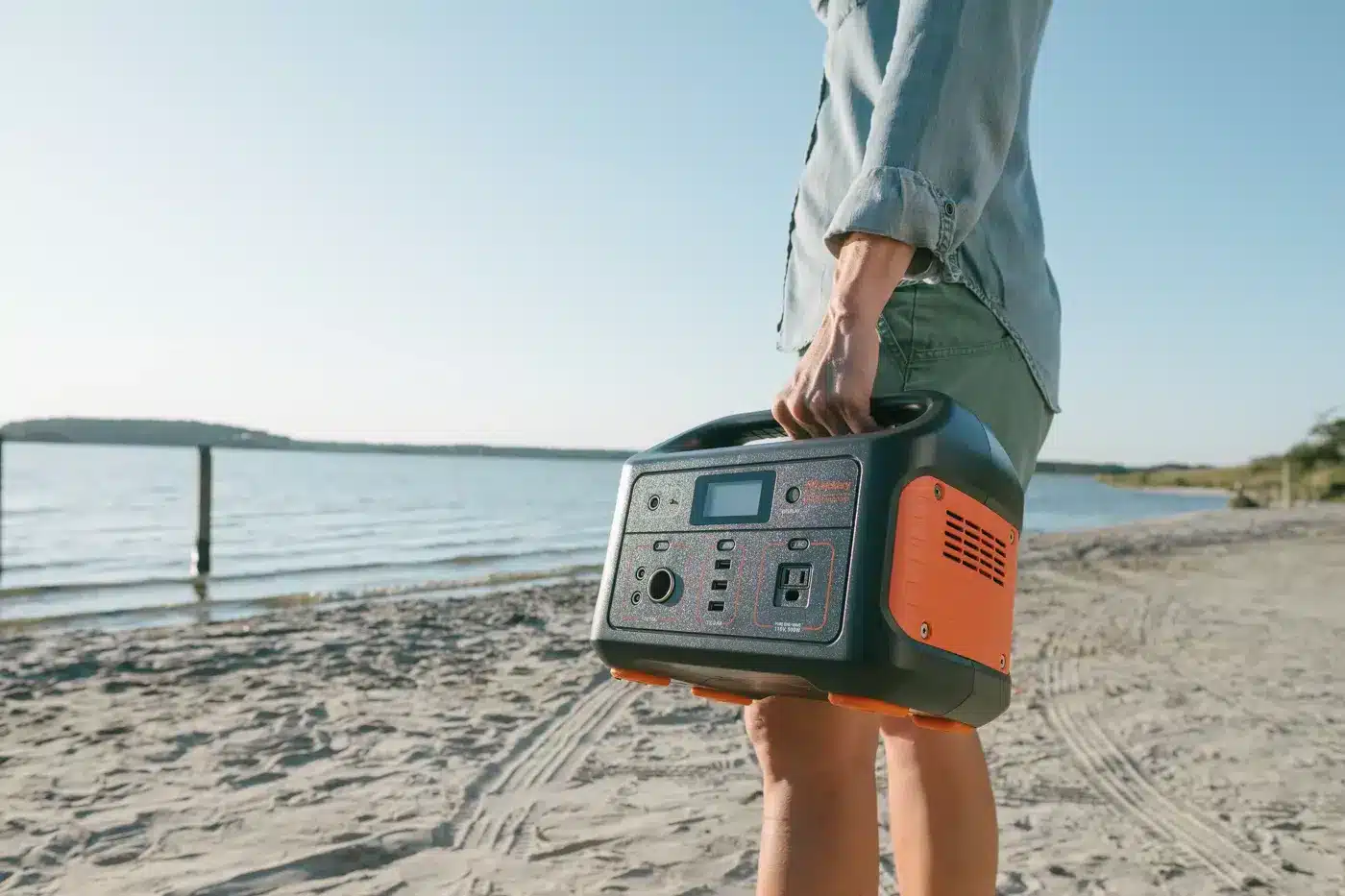
Power Stations are thus technological boxes designed as all-in-one solutions to meet the energy needs of those who need a powerful, yet portable and easy to understand, install and use electrical system.
Because of portability and ease of use, they are popular with fans of camping, barbecues, or beach parties.
Recently, however, with the growing interest in camper vans and do-it-yourself van conversions., these battery-generators are getting closer and closer to the RV world as well.
Either as energy back-ups or in some cases as an actual electrical system.
In the next section we look together at when and how much sense it makes to buy a power station for your RV.
If, on the other hand, you do not have an RV, and you are only here for the detailed comparison of themost popular Power Station models on the market, you can skip directly toparagraph 4.
2. When does a Portable Power Station in a Motorhome make Sense?
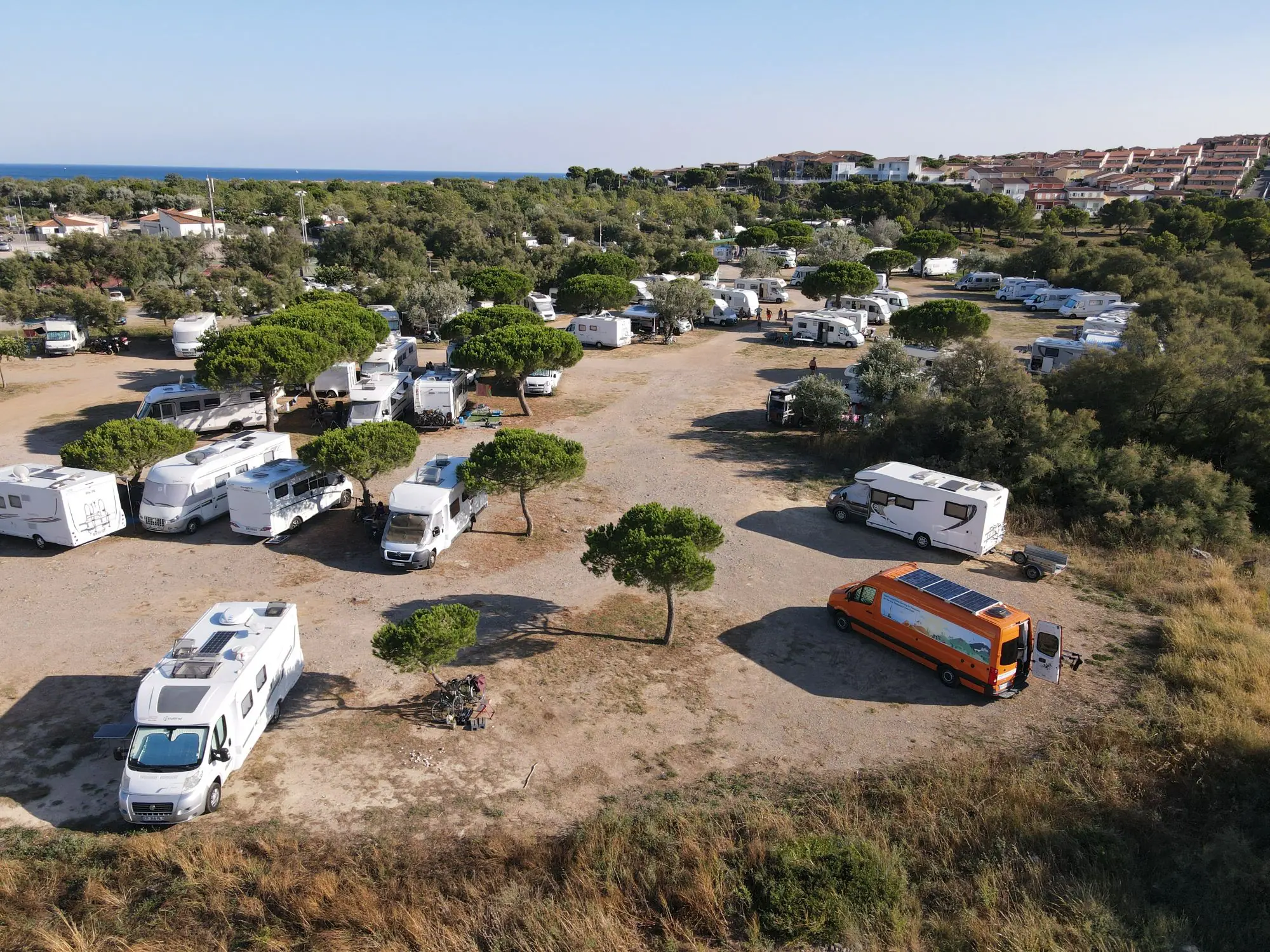
Below we look together at the reasons why it would make sense and you might be interested in buying a portable power station for your RV.
- Creating an Easy Electrical System: If you’re converting a van DIY and have no idea where to start getting your hands on electricity, you have three options: hire an expert (expensive), learn how to build a DIY Electrical System(time-consuming), or buy a power station (ready to use!).
(In the next section, we compare power stations in detail with an electrical system on the basis of both power output and economic cost.
- Creating an Electrical Installation for a Removable Conversion: if you’re converting an RV, van or minivan with a temporary, removable outfitting, Power Stations are a great option for getting a decent level of comfort without having to wire anything permanent to your vehicle
- Increasing the range of the Current System: Service batteries are the heart of every RV. But what happens in case we want to increase the capacity? Often, adding service batteries is not as easy as it sounds: there is a lack of space in the locker, the rest of the system is undersized, and we would need to change various electrical components. Even more complicated is to change an AGM system for a lithium system (all charging systems would have to be changed). In such cases, adding an external PS may be the easiest, most convenient, and most economical solution to meet our new electrical needs
- Emergency Power Backup: Are you planning long on-the-road trips or planning to visit remote areas? Is electricity essential for you to work and travel? Since you never know when bad luck will strike (unlike luck which is blind, bad luck can see just fine!), a Power Station could be that emergency plan B that saves you in difficult conditions. If you have extra space in your RV to devote to it, for adventure travel it can always be an extra security.
- To Best Enjoy Stopovers and Camping in Nature: Leave the van in the sun (to charge service batteries), set up in the shade of a tree, small table, chairs, nature, barbecue and cold beer! The best part of vanlife for me is all here! In such cases, a power station can come in very handy for feeding extra comforts: the pc for remote work, the cell phone, a fan on hot summer days, a speaker for music…possibly as well as a cooler to keep the beers even more ice cold and within reach ;D In camping and conviviality situations certainly is where the benefits of portable Power Stations are most enjoyed.
Now that we have seen the reasons why it might be interesting to consider the option of a Power Station for your RV, you will surely be interested in understanding what are the best options on the market.
Before jumping in, however, I offer a little food for thought in case you are converting a van and are undecided whether to create a complete electrical system or install a power station.
If this is not the case for you, skip ahead to the Best Power Stations on the Market in 2023).
3. Portable Power Station vs Camper Electrical System: Advantages and Disadvantages
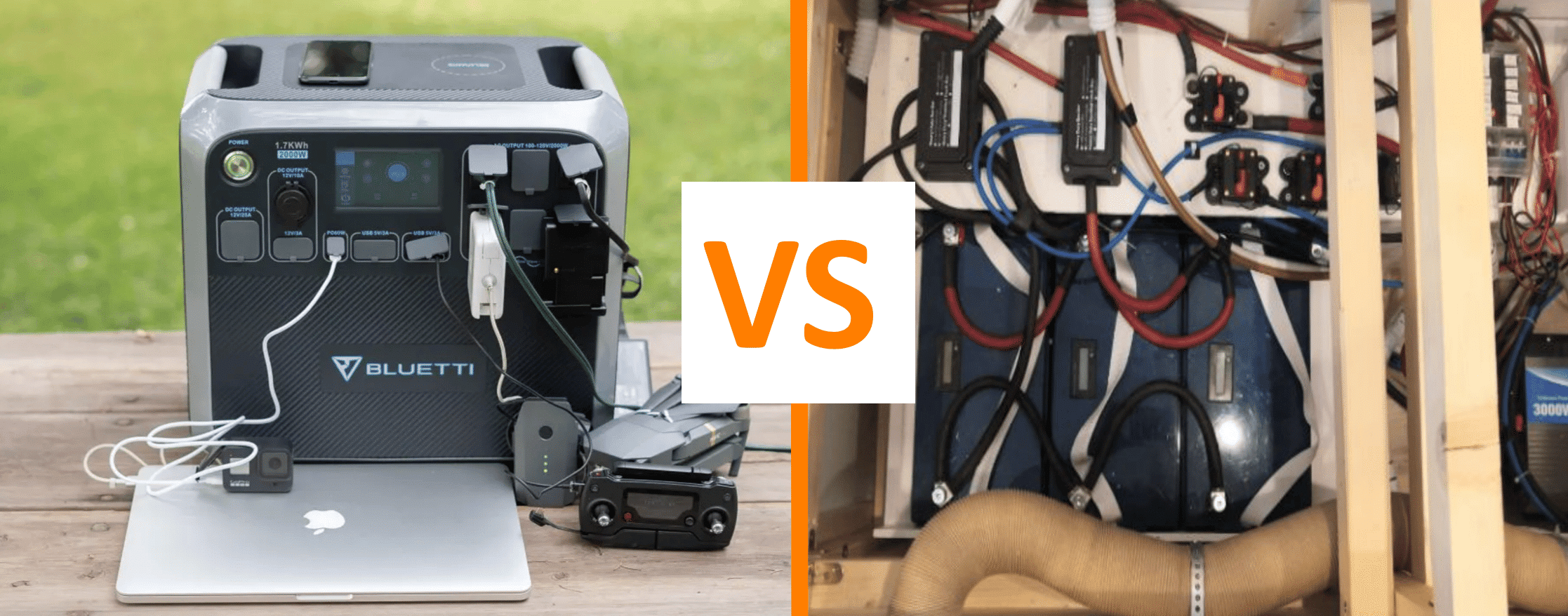
Below, find the advantages and disadvantages of using a Power Station to power a camper’s utilities, compared to a “fixed” electrical system.
CHOOSE A POWER STATION TO CREATE AN ELECTRICAL SYSTEM
ADVANTAGES
- It can be removed and charged at home
- For light installations (<100ah), cheaperthan a full electrical system (to charge two phones and a PC, no point in doing all the work of installing a system)
- Great for camping outdoors and powering your electrical equipment outside your RV without the need for extension cords
- Excellent Solution for Mobile Set-ups, as it does not require any complex wiring/connections
- Simple to Use without the need for complicated installations
- Much lighter than a full electrical system (affects fuel consumption)
- Safe and Reliable: PS contain within them all the necessary protections against over/under-voltages, overloads, short circuits etc.
CONS
- For powerful systems (150ah +), the cost of Power Stations is much higher (almost double!) than that of a lithium electric system (the most expensive and highest performing).
- It is not as elegant a solution as a complete RV system: all the cables remain mostly in sight
- Inconvenient to support a complex 12V system with attached fuse box
- If it were installed as a “battery bank” as the basis for a fixed system, it would lose its portability
- Short warranty: on average just 2 years, while quality RV batteries offer at least 5 years
- In the unfortunate event of failure, it cannot be repaired DIY: back to the producer if it is under warranty, otherwise it must be replaced. In the process, you are left without electricity.
FINAL JUDGMENT
Portable Power Stations are a fantastic accessory to INTEGRATE an RV’s electrical system: as an emergency solution, to enhance outdoor camping, as an extra battery to increase range etc.
Conversely, Power Stations are NOT suitable to REPLACE an RV’s electrical system (and they were not even designed to do so!).A well-designed electrical system will always offer more power and convenience, compared to a PS.
The only exceptions, make them the case that you are converting a van with a removable set-up or otherwise your energy needs are really low.
In these cases alone, buying a Power Station would be cheaper and more convenient than installing a complete system.
If you are interested in knowing how theelectrical system of an RV works and how to build one that suits your needs entirely Do-It-Yourself, I recommend reading this guide.
4. Best Choices on the Market: Bluetti, Ecoflow and Others
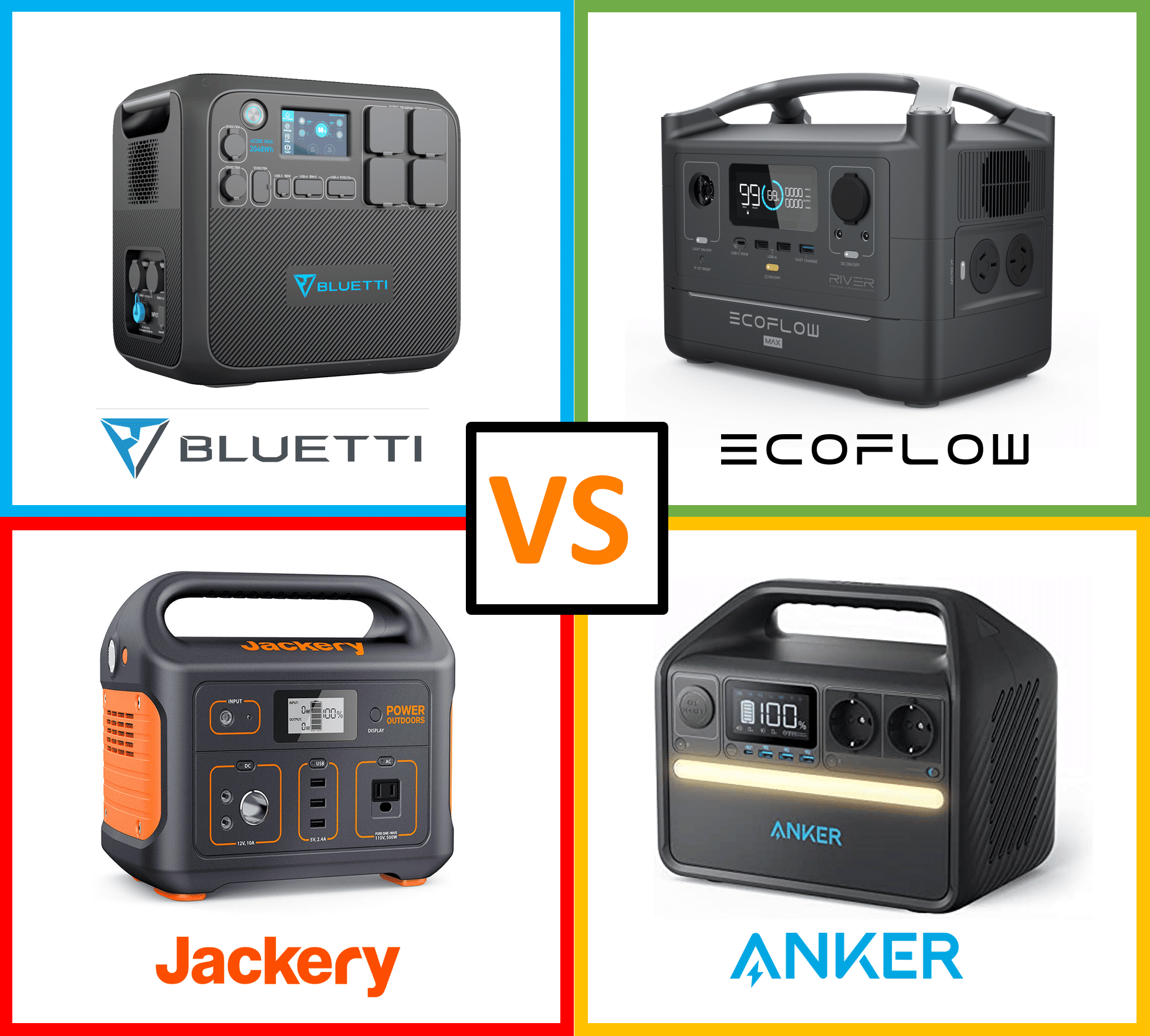
Below I briefly show you which pricipal companies are currently producing Power Stations for camping and RVs.
Bluetti and Ecoflow of course are the undisputed leaders in the field, while I wanted to include Jackery and Anker as emerging alternatives potentially worth considering.
MAJOR MANUFACTURERS OF PORTABLE POWER STATIONS
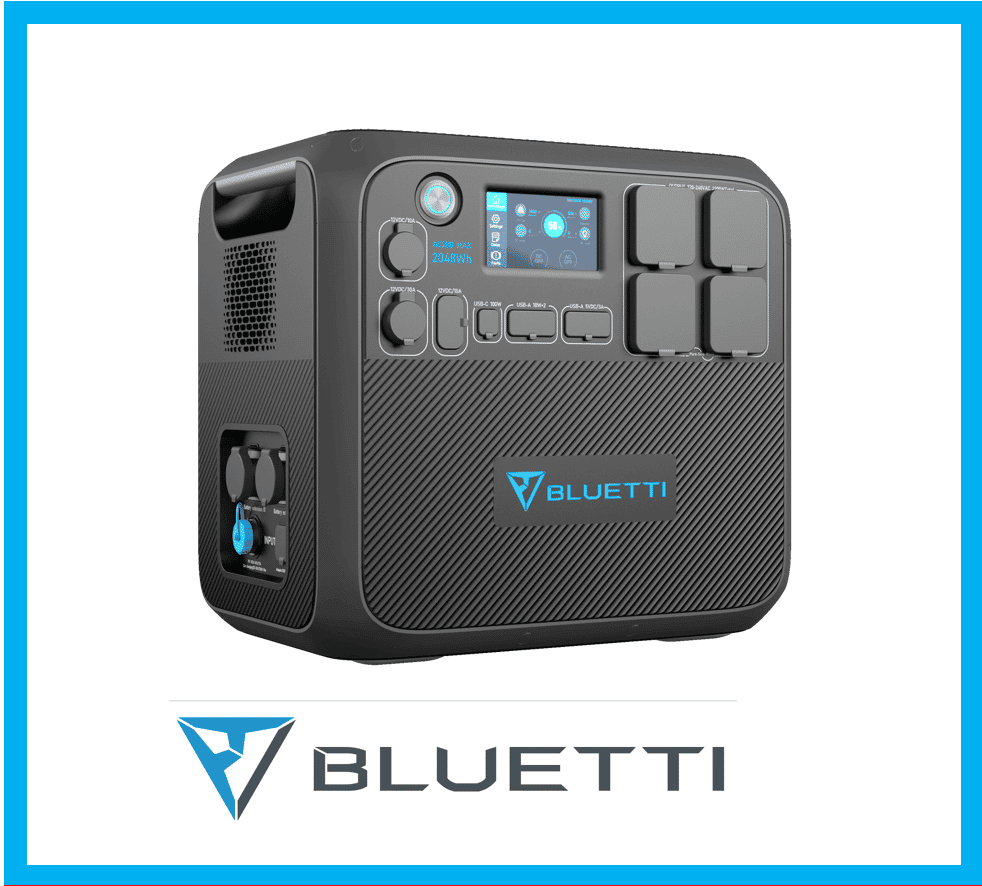
BLUETTI
A very young U.S.-based company that launched its first power stations in 2019, immediately enjoying huge success on social media and crowdfunding platforms.
At the moment, Bluetti Power Stations are among the most popular in America, Europe, and Italy, and enjoy wide support from influencers and campers who testify to the high quality of their products. The special feature of Bluetti Power Stations is that they are modular and expandable with extra batteries.
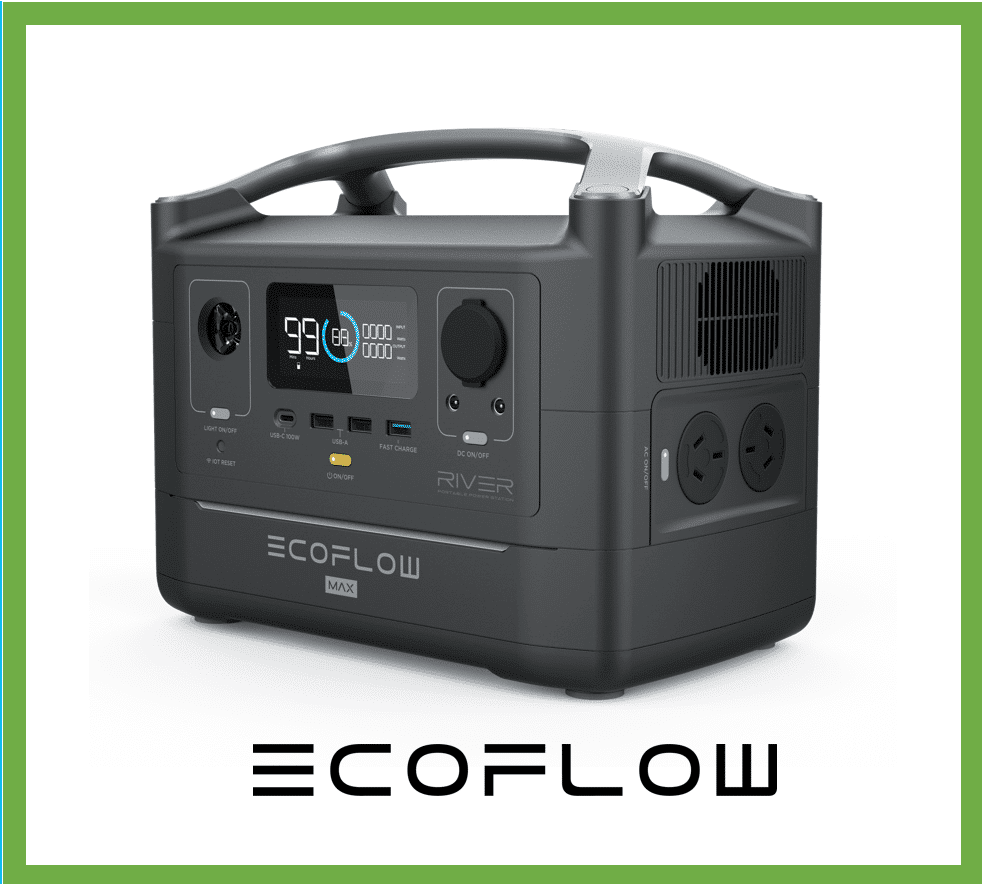
ECOFLOW
Chinese/American company founded by a group of engineers, a leader inportable power and renewable energy since 2017.
Ecoflow Power Stations are quality products whose major selling points arereliability and ultra-rapid charging (although competitors are getting quite close).
Definitely one of the companies to keep an eye on and one that offers really interesting quality/price products.
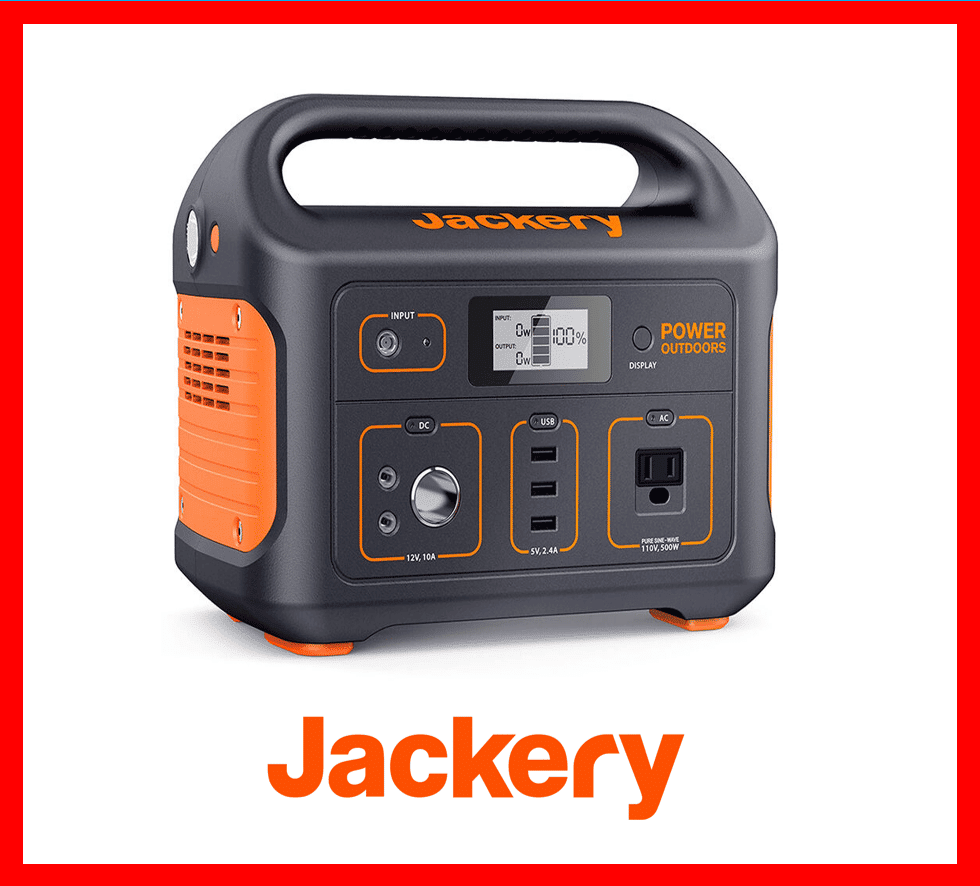
JACKERY
A brand still little known in Italy, but extremely famous in the United States (and among the world’s best-selling Portable Power Stations).
Jackery is a California company established in 2012 that offers animpressive range of different small/medium sized power stationmodels.
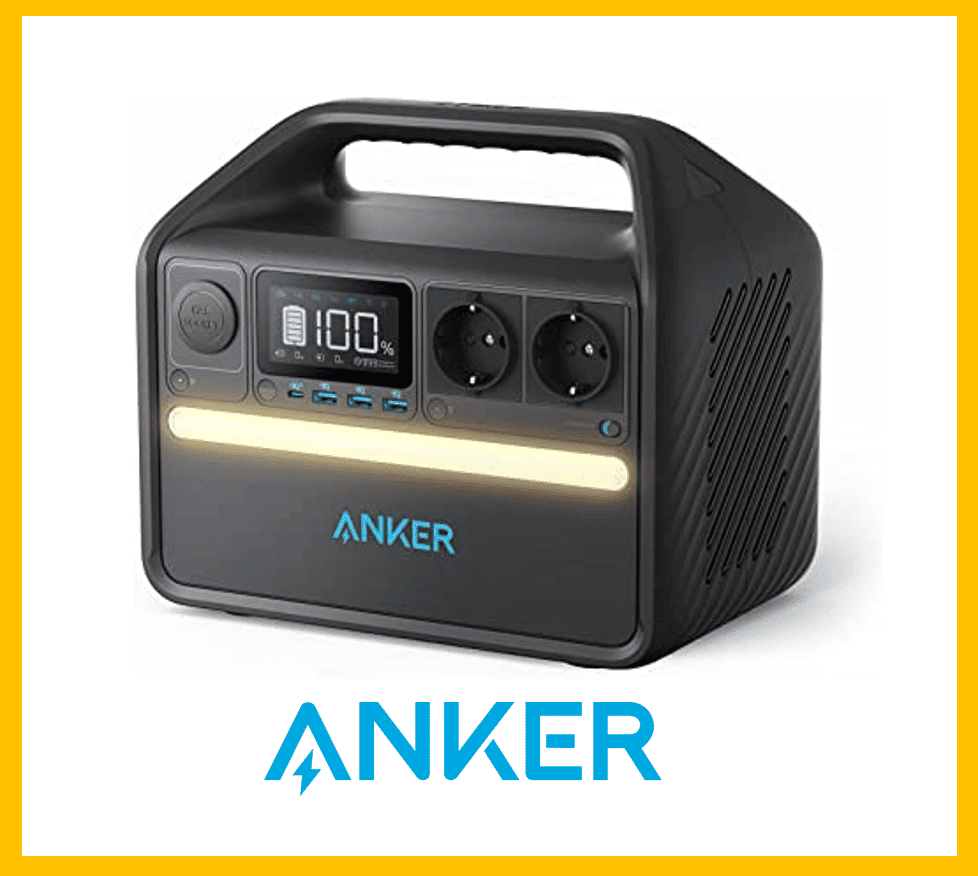
ANKER
Anker is a Chinese company that you may have already heard of when talking about quality powerbanks or batteries for laptops/smartphones.
Well, last year Anker decided to go bigger and launched its first portable Power Station-a good product that has nothing to envy from more emblazoned brands such as Ecoflow, Bluetti or Jackery.
5. Portable Power Stations: Models on the Market
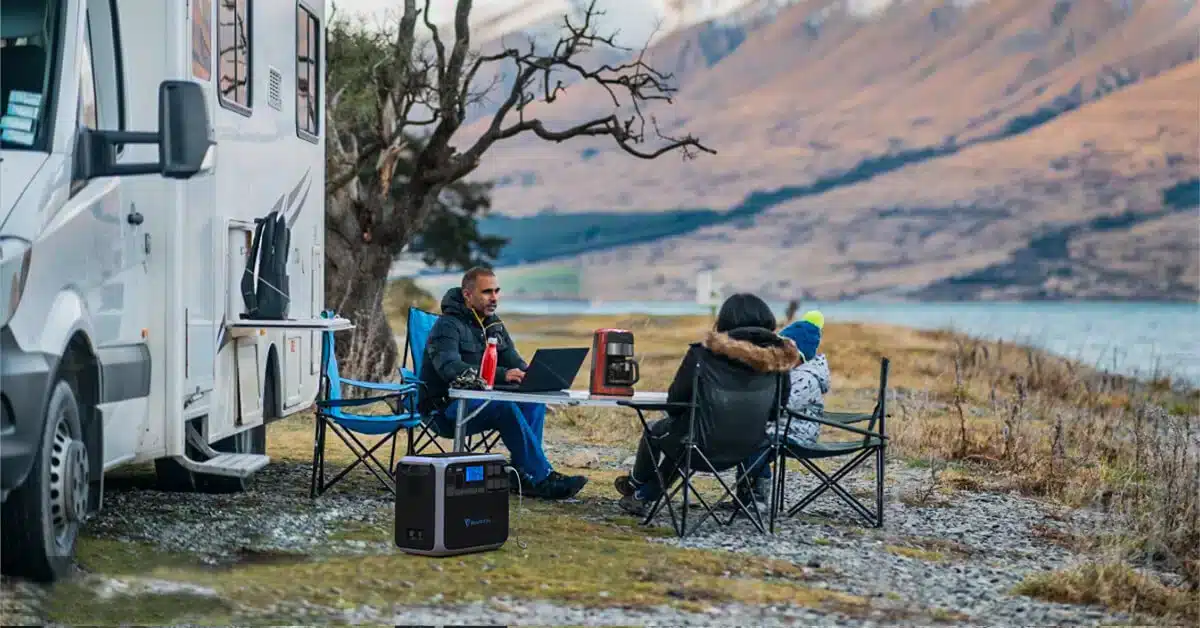
Now that we have seen the major manufacturers of Power Stations, it is finally time to see what products they offer and which ones are best suited to RV living.
To simplify your search (seriously, the world of power stations is a jungle!), I wanted to collect all major models from each manufacturer in convenient tables.
To help you choose, I have removed all the “outline” of additional information and left only the specifications that really matter and should guide your choice: battery capacity, inverter power, DC output power, and Base Price.
Before looking at the models, I will briefly clarify what is meant by each of these specifications.
BATTERY CAPACITY
Battery capacity is essentially the amount of energy you can stow in a power station-it goes without saying that it is the ultimate and fundamental reason why you might decide to purchase such an acessory.
The greater the capacity, the more autonomy you will have.
Normally power station manufacturers report capacity in watt-hours. In the tables below, I have translated this capacity to you in Amper-hours (the same unit used to measure the capacity of RV batteries-it is obtained by dividing watt-hours by the voltage of 12.8V).
This way, you can easily compare the capacity of the Power Station with that of a regular lithium battery and better evaluate its price.
If you find it too complicated, don’t worry I will help you in the next few paragraphs to get clarity on the numbers.
For now, I’ll leave a table here to give you a sense of what you can do with different stowage capacities:
WHAT CAN POWER A POWER STATION BATTERY AND FOR HOW MUCH?
| BATTERY CAPACITY | Smartphone Charger (20W) | Laptop Charger (60W) | TV Media (150W) | Hairdryer (1200W) |
| 20Ah | 13 hours | 4 hours | 1h45min | NO |
| 50Ah | 32 hours | 10,5 hours | 4h20min | NO |
| 100Ah | 2,5 days | 21 hours | 8h30min | 1 hour |
| 200Ah | 5 days | 1,5 days | 17 hours | 2 hours |
| 300Ah | 7,5 days | 2,5 days | 1,5 days | 4 hours |
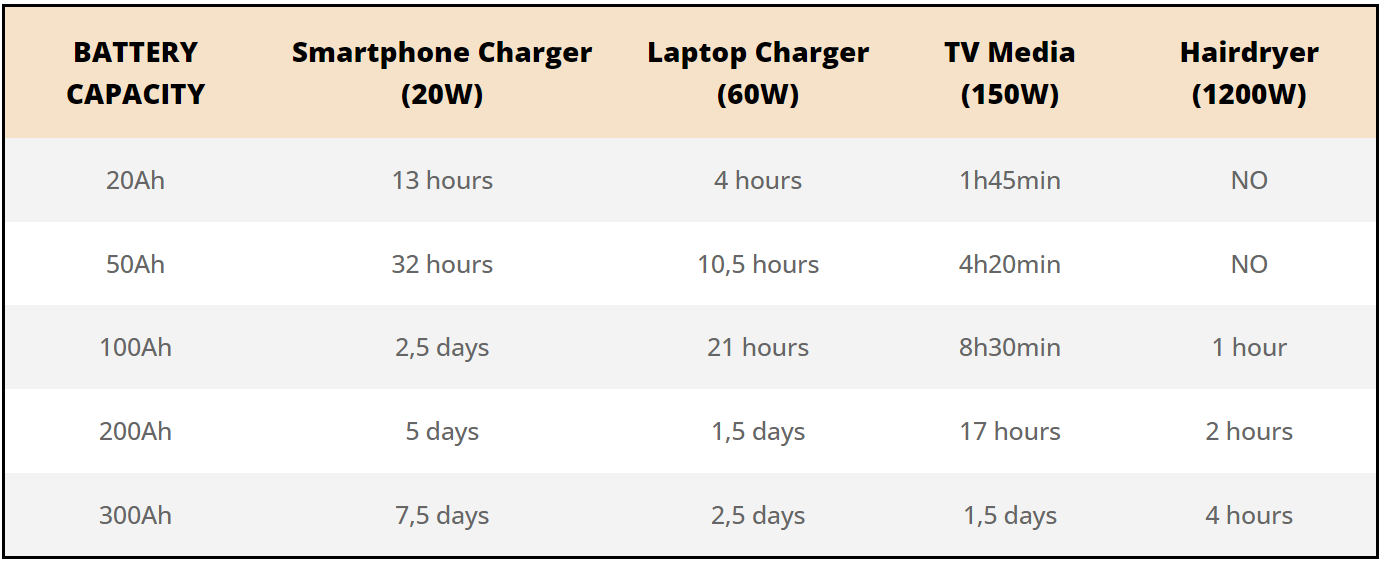
INVERTER POWER
The inverter is an apparatus already inside the Power Stations that converts 12V battery current into 110-220V alternating current usable by your equipment (TV, PC, Phon, Kettle etc.).
The more powerful the inverter, the more devices at the same time you will be able to power. Below, I leave you a table summarizing the average consumption in watts of various electrical equipment.
HOW MUCH DO HOME APPLIANCES CONSUME ON AVERAGE?
| APPLIANCE | AVERAGE POWER REQUIRED |
| WASHING MACHINE | 2200 WATT |
| INDUCTION COOKTOP (1 FIRE) | 2100 WATT |
| IRON | 1800 WATT |
| HAIRDRYER | 1300 WATT |
| ELECTRICAL HEATER | 1200 WATT |
| BOILER | 1000 WATT |
| AIR CONDITION | 1000 WATT |
| COOKING MIXER | 400 WATT |
| THERMOELECTRICAL FRIDGE | 180 WATT |
| TV | 150 WATT |
| PC CHARGER (POWERFUL) | 120 WATT |
| PHONE CHARGER (POWERFUL) | 25 WATT |
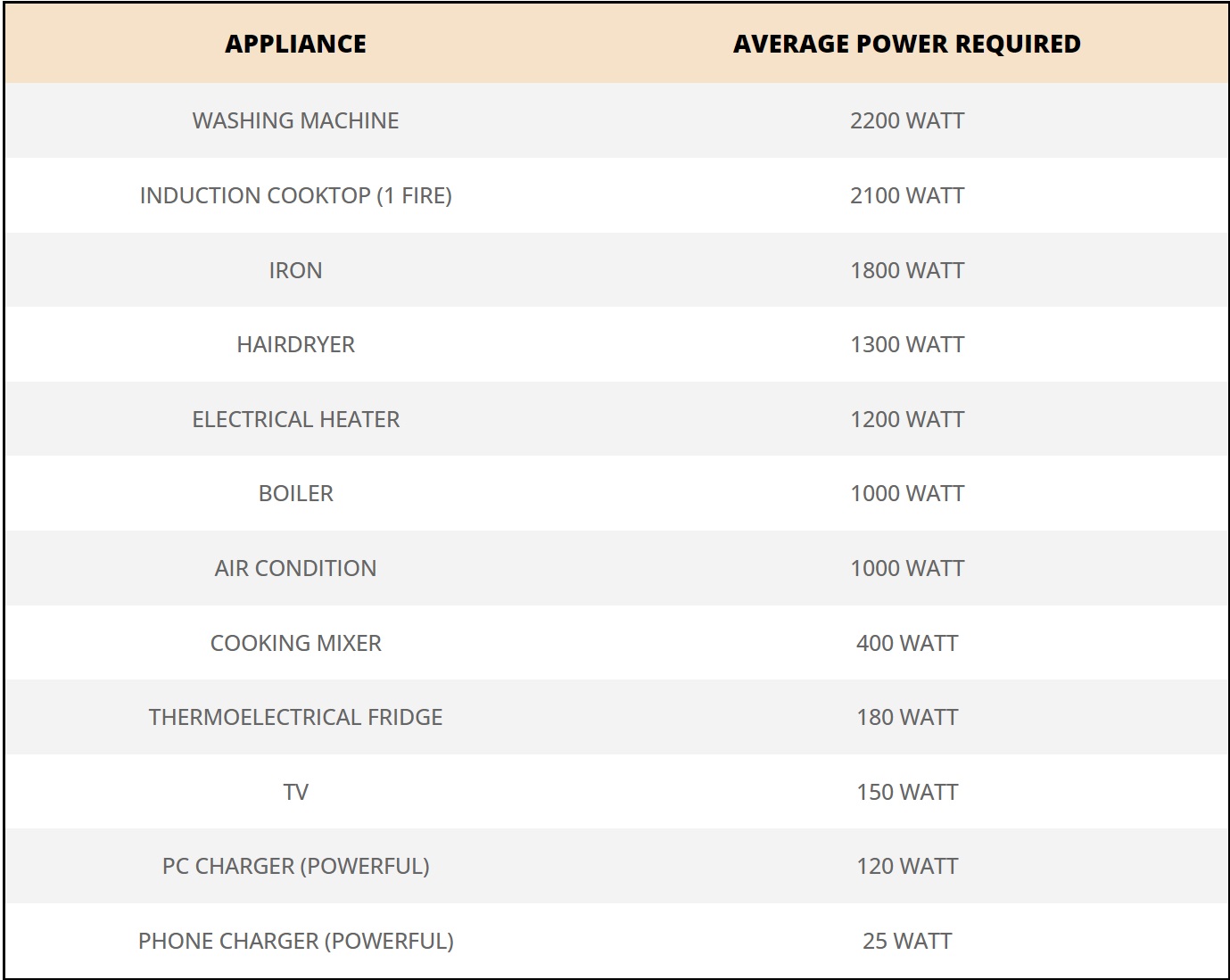
Suppose you want to power a TV set and charge your PC at the same time: in this case the powers add up (150W TV set + 120W charger = 270Watts) and means that to do this you will need a portable power station that supports at least 270W of power.
POWER OUTPUTS 12DC
If you are considering using a portable power station as part of your RV’s electrical system, you probably already know that many “RV” equipment runs on 12V direct current.
These include, to give examples, verie LED lights, ceiling fans, water pump, compressor refrigerators, 12V air conditioners etc.
If you are planning to power such devices, you need to make sure that the Power Station has normal DC outputs (not just USB-A or USB-C) and enough power to power them.
BASIC PRICE
A good comparison obviously cannot be made without price.
To help you choose, I have gathered all the base list prices of all the Power Stations currently on the market (2023) in the tables below.
Of course, depending on the period, you may come across offers whereby one Power Station may become more attractive than others.
Now that I have explained the main features to consider when choosing a Portable Power Station, let’s look together at all the models on the market offered by Bluetti, Ecoflow, Jackery, and Anker.
If you are interested in seeing the full product description, simply
click on the table to go directly to the manufacturer’s website.
To make the comparison with an RV/van’s electrical system easier, I have translated your battery capacity from Wh to Ah (same unit of measurement by which RV battery capacity is normally measured).
To find the Wh, just multiply by 12.8V.
PORTABLE POWER STATION MODELS

| PS for Small Projects | Ah Capacity | Inverter | DC Outlets | Base Price |
| BLUETTI EB3A | 21Ah | 600W | 10A | 299 EURO |
| BLUETTI EB55 | 42Ah | 700W | 10A | 649 EURO |
| BLUETTI EB70 | 56Ah | 1000W | 20A | 799 EURO |
| PS for Medium Projects | Ah Capacity | Inverter | DC Outlets | Base Price |
| BLUETTI AC200P | 156Ah | 2000W | 25A | 1699 EURO |
| BLUETTI AC200MAX | 160Ah | 2200W | 40A | 1899 EURO |
| PS for Big Projects | Ah Capacity | Inverter | DC Outlets | Base Price |
| BLUETTI AC300+B300 | 254Ah | 3000W | 50A | 3999 EURO |
| BLUETTI B300 BATTERIA EXTRA | 240Ah | - | 10A | 2399 EURO |
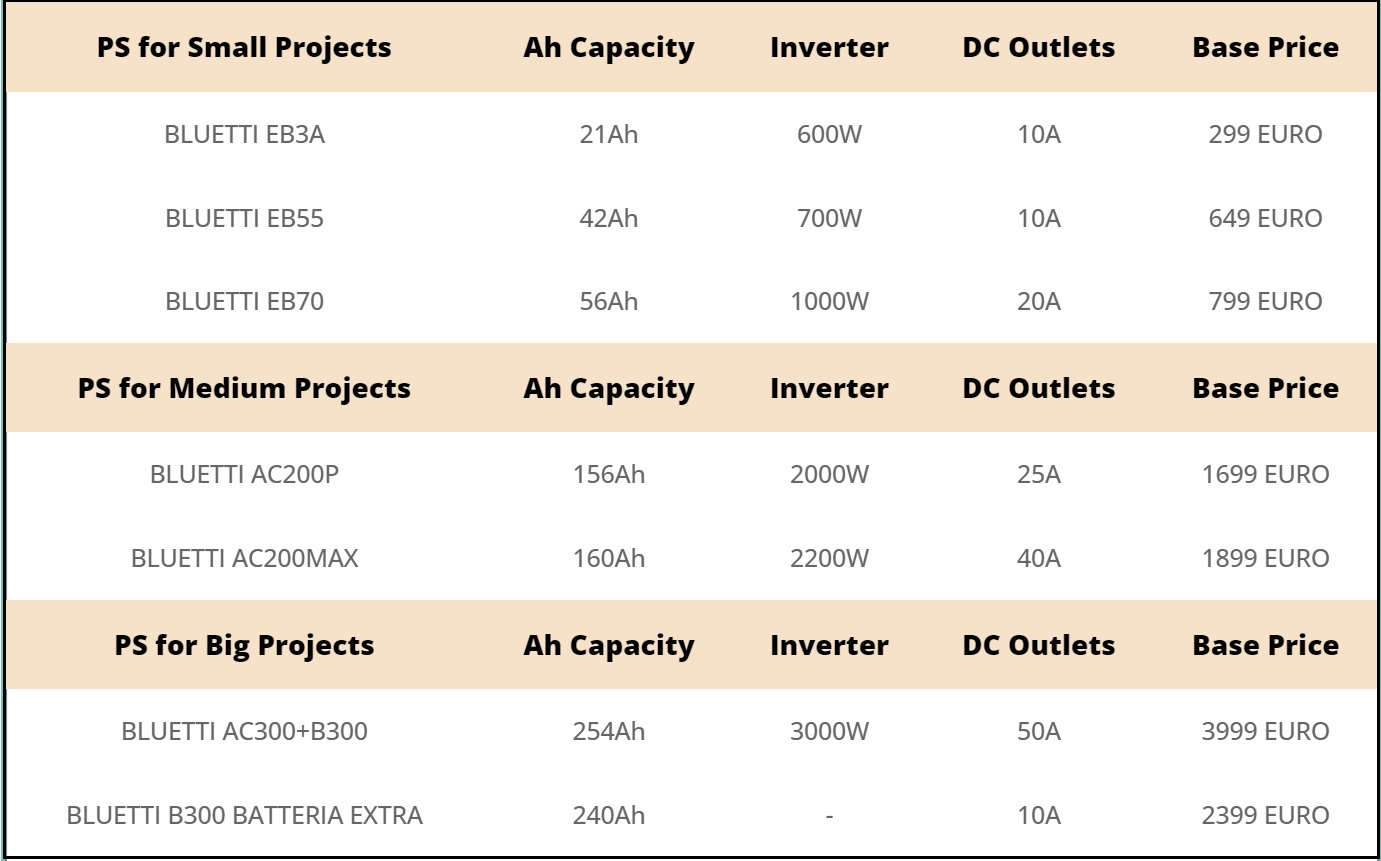
Note: Almost all Bluetti Power Stations are expandable with additional Bluetti batteries.
| PS for Small Projects | Ah Capacity | Inverter | DC Outlets | Base Price |
| ECOFLOW RIVER 2 | 20Ah | 300W | 8A | 299 EURO |
| ECOFLOW RIVER 2 MAX | 42Ah | 1000W | 10A | 599 EURO |
| ECOFLOW RIVER 2 PRO | 60Ah | 800W | 5A | 799 EURO |
| ECOFLOW DELTA MINI | 69Ah | 1400W | 5A | 1099 EURO |
| ECOFLOW DELTA 2 | 79Ah | 1800W | SOLO USB | 1199 EURO |
| PS for Medium Projects | Ah Capacity | Inverter | DC Outlets | Base Price |
| ECOFLOW DELTA PRO | 281Ah | 2600W | SOLO USB | 3999 EURO |
| PS for Big Projects | Ah Capacity | Inverter | DC Outlets | Base Price |
| ECOFLOW DELTA MAX | 254Ah | 2500W | SOLO USB | 2299 EURO |
| BATTERIA DELTA EXTRA | 156Ah | - | - | 3998 EURO |
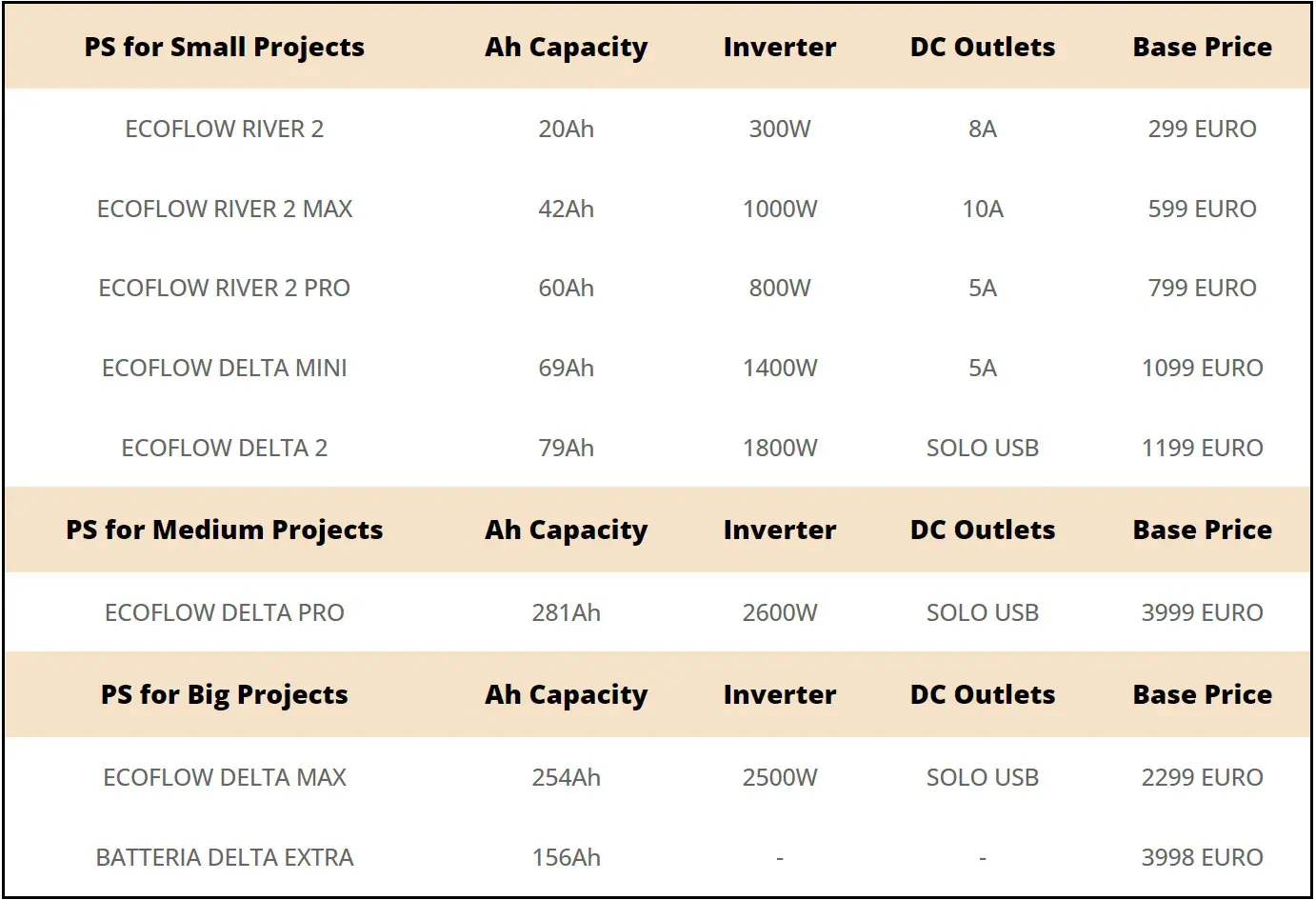


| PS for Small Projects | Ah Capacity | Inverter | DC Outlets | Base Price |
| ANKER 521 | 20Ah | 200W | SOLO USB | 369 EURO |
| JACKERY EXPLORER 500 | 42Ah | 500W | 10A | 659 EURO |
| ANKER 535 | 42Ah | 500W | SOLO USB | 699 EURO |
| JACKERY EXPLORER 1000 | 79Ah | 1000W | 10A | 1249 EURO |
| ANKER 757 | 96Ah | 1500W | SOLO USB | 1499 EURO |
| PS for Medium Projects | Ah Capacity | Inverter | DC Outlets | Base Price |
| ANKER 767 | 160Ah | 2300W | SOLO USB | 2499 EURO |
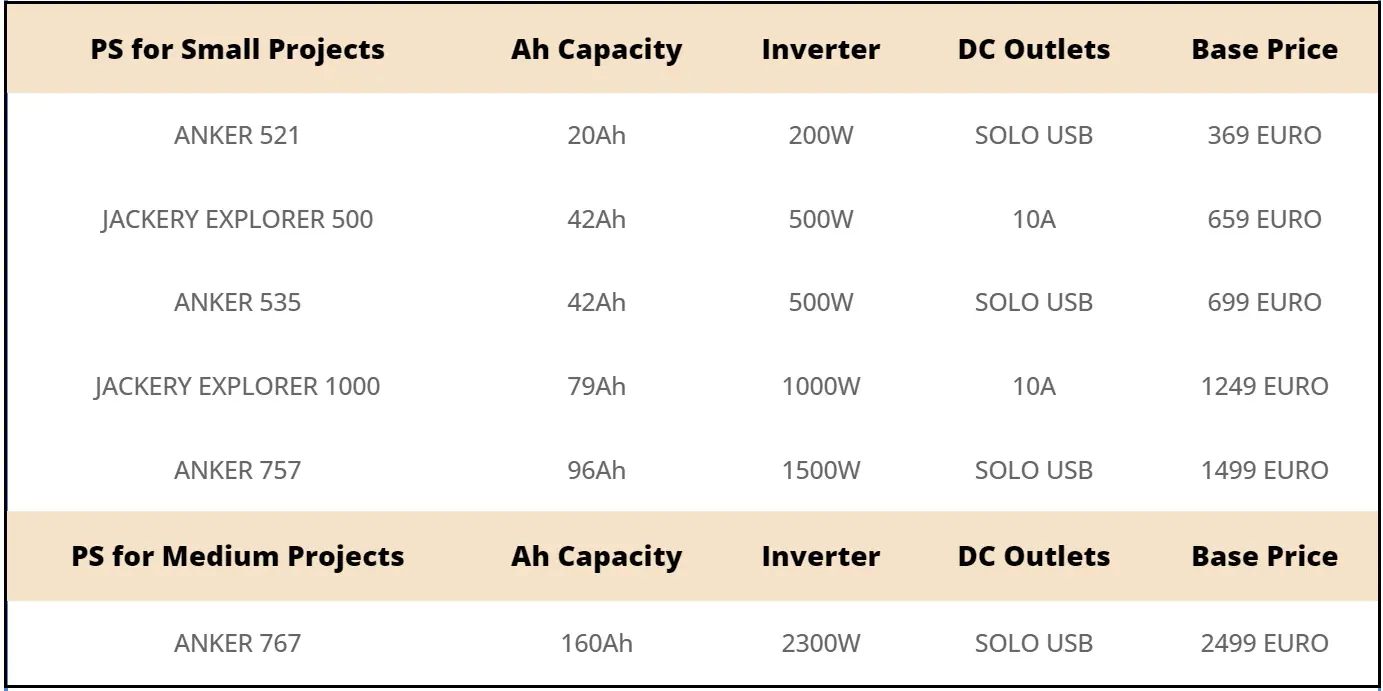
Note 1: Jackery and Anker are not expandable with extra batteries.
Note 2: Anker offers a 5-year warranty, versus an average of 2 years from other manufacturers.
6. Bluetti vs Ecoflow: Detailed Comparison
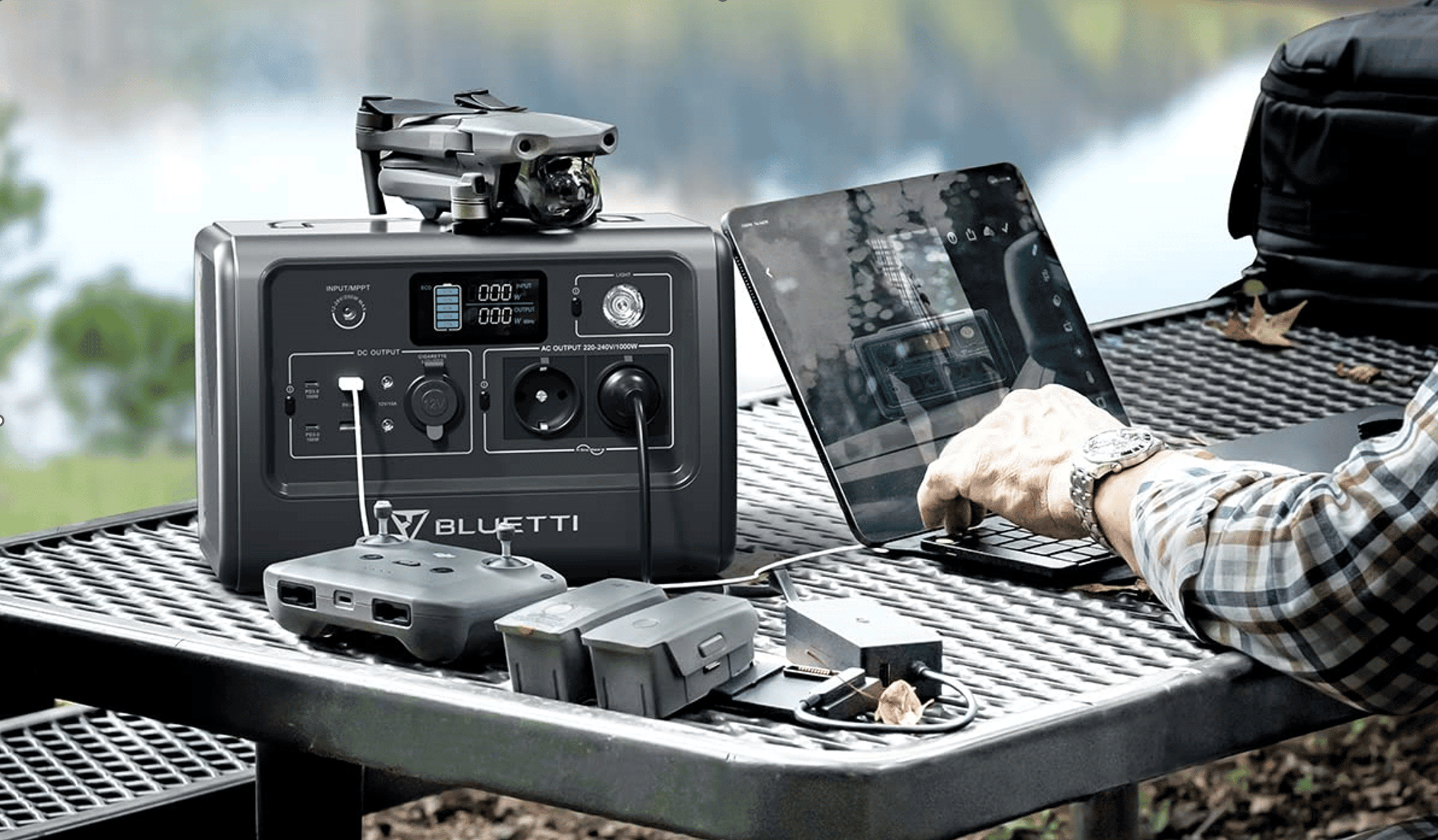
Now that we have seen the power station models on the market, it is time to compare them and draw conclusions.
In order, we will look in more detail at Portable Power Stations for camping and small projects (<100ah), for medium (100-300ah) and large (250ah+) projects.
POWER STATION FOR SMALL PROJECTS
In this category, let’s together try to figure out which Power Station is “just right” for casual use, whether an outdoor barbeque, charging phones or computers, a beach party, or occasionally some RV accessories.
Speaking of small projects, we can see that all manufacturers (Bluetti, Ecoflow, Jackery, and Anker) have a proposal suitable for this range of use.
ENTRY-LEVEL POWER STATION (20Ah)
Starting from the low end (20Ah capacity), we see that the Bluetti EB3A is sold at the same price as the Ecoflow River 2 and Anker 521. They have the same capacity, same price, however, the PS Bluetti EB3A has twice as many inverters as its competitors and 12V DC outputs as well.
Therefore, in this category there is no match and the Bluetti EB3A wins the title of best entry-level power station.
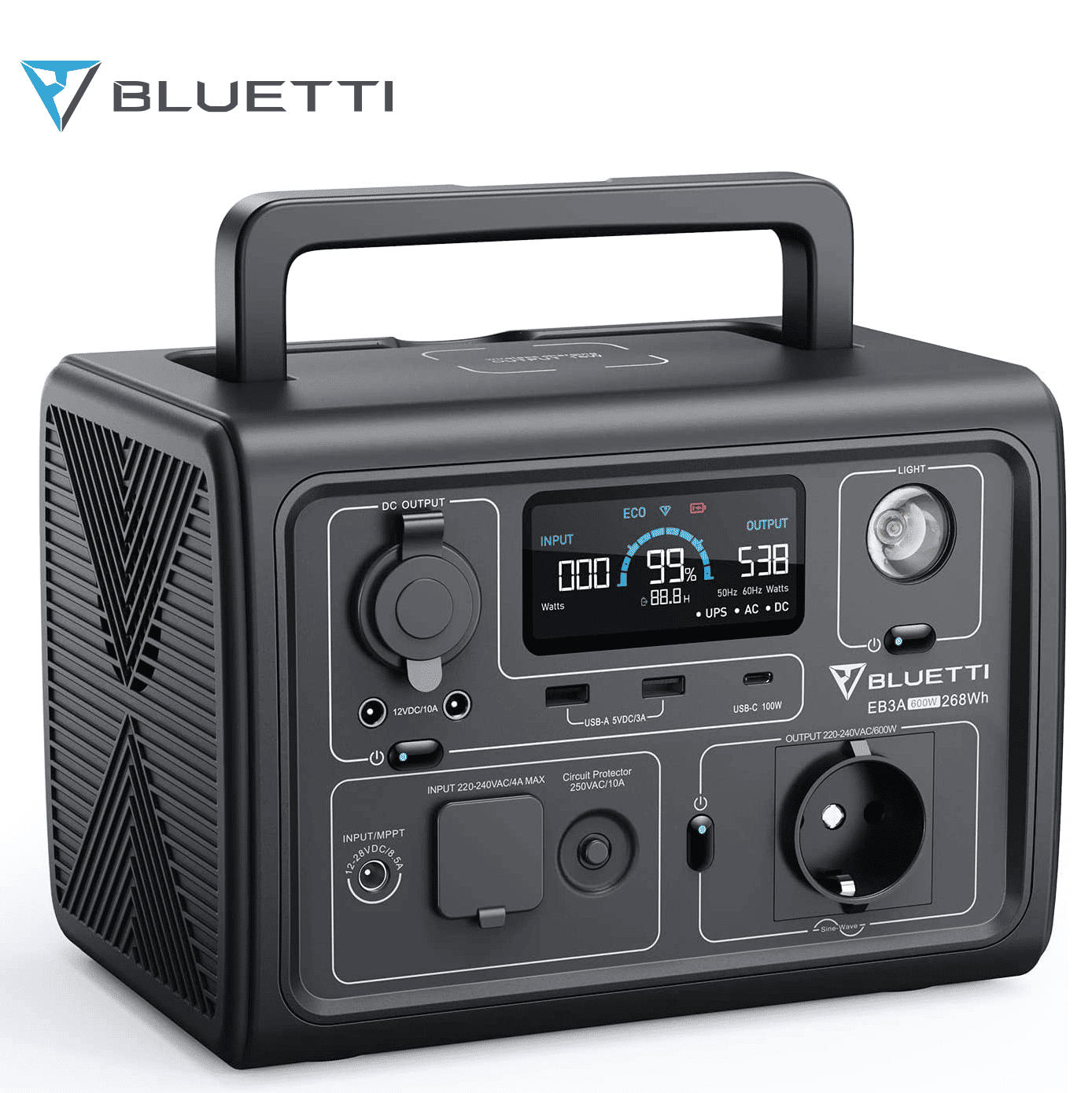
WINNER: BLUETTI EB3A
BEST ENTRY-LEVEL POWER STATION
BATTERY: 21Ah
INVERTER: 600Watt
DC: 10Amp
WEIGHT: 4.6Kg
SOLAR: Max. 200Watt
WHAT CAN YOU FEED US?
Charge a Smartphone 25 times or a PC 3.5 times
POWER STATION BASE (up to 100Ah)
In the range between 30 and 100ah is where we find the largest number of portable power stations, with prices ranging from 600Euro up to 1500Euro.
In this category, of more or less similar PSs, the only one that seems to stand outa good step above the others is the Ecoflow Power Delta Mini, which reaches with its inverter a power of as much as 1400Watts (unbelievable for such a small PS!). For comparison, in this category the others barely reach 1000W.
The only negative note, is that the Mini has only 5A output at 12V (compared to the 20A of the Bluetti EB70 which costs even less).
Unless you want to use it to power 12V equipment in your RV, the Mini’s great inverter power anyway makes it the best in this category.
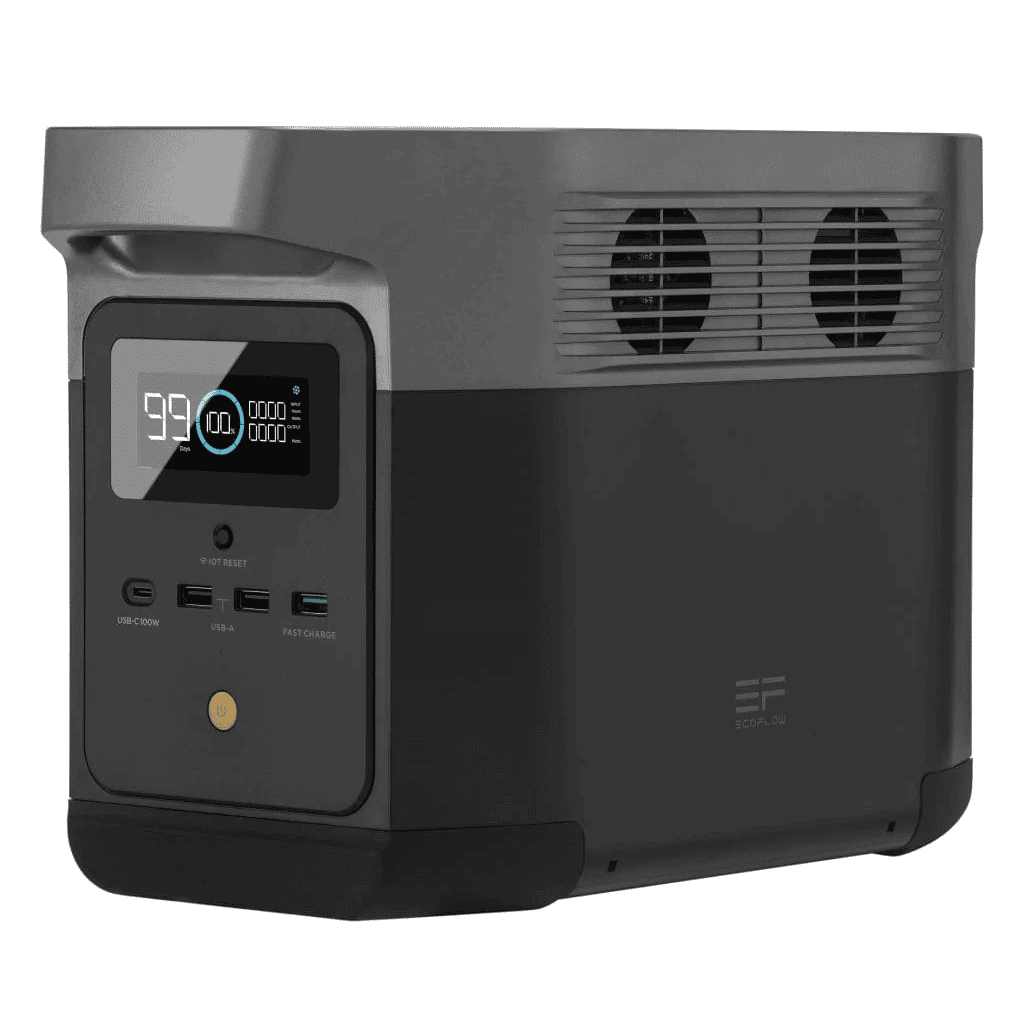
WINNER: ECOFLOW DELTA 2 MINI
BEST POWER STATION FOR SMALL PROJECTS
BATTERY: 69Ah
INVERTER: 1400Watt
DC: 5Amp
WEIGHT: 10.7Kg
SOLAR: Max. 300Watt
WHAT CAN YOU FEED US?
Smartphones, Laptops, Kettle, Hair dryer and any other household appliances in common use
POWER STATION FOR MEDIUM-SIZED PROJECTS
100-300Ah
Power Stations within this category are beginning to be important and more weighty pieces of equipment, useful both as back-up solutions (in RVs for example!) and potentially to power low-consumption electrical systems.
Going up in range, as you may have noticed in the tables above (on each manufacturer’s models), the choice narrows.
In this category, the model that more than the others Easily jumps out at you for its excellent quality/price is the
BluettiAC200Max
: decent 160ah battery, excellent invert power (2200Watts), an incredible 12V output of a whopping 40Amps (enough to power any utility in an average RV), and a price that still manages to stay well under 2000Euro.
Jackery does not produce medium to large power stations, Anker is still too far out of price while Ecoflow really does not have a product that fits well in this category.
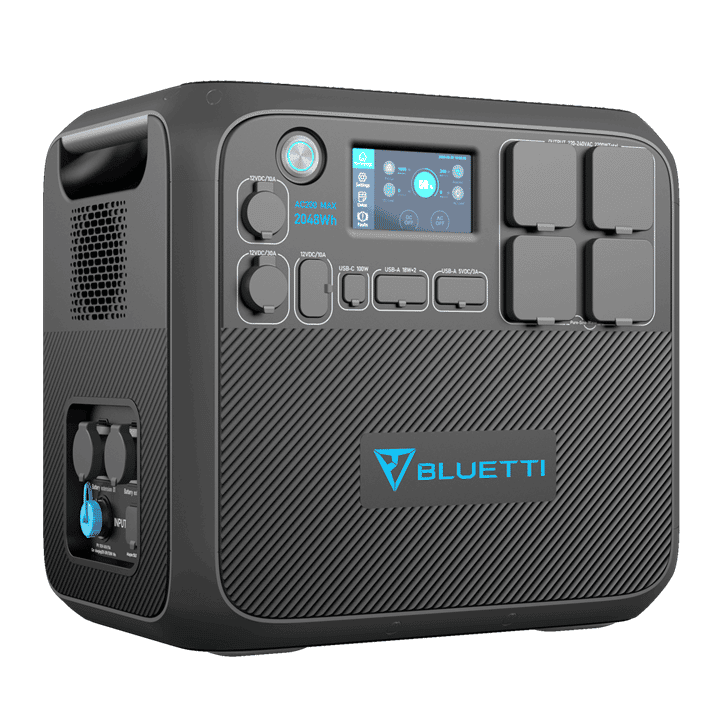
WINNER: BLUETTI AC200MAX
BEST POWER STATION FOR BACK-UP AND MEDIUM-SIZED PROJECTS
BATTERY: 160Ah
INVERTER: 2200Watt
DC: 40Amp
WEIGHT: 28Kg (!)
SOLAR: Max. 900Watt
WHAT CAN YOU FEED US?
Hair dryer, Kettle, PC, Smartphone, and all 12V appliances that are normally found in an RV (pump, fan, LED, compressor refrigerator etc.).
POWER STATION FOR LARGE PROJECTS
300+Ah
And here we come to the Power Stations for large projects. Here we are talking about real electrical equipment, relatively heavy (over 50kg) and therefore not so “portable” to move around every day.
If you are considering using Power Stations to create a complex electrical system in a van/camper, and with a large range (above 300Ah), you need to know two things.
First, the choice here is Bluetti or Ecoflow. There are no other alternatives at the moment.
Second, be prepared to spend!
Comparing the Ecoflow DELTA Max with theBluetti AC300+B300, we see that both power stations are modular and expandable.
Their capacity is practically the same (254Ah). The Bluetti offers a 3000W inverter compared to the Ecoflow’s 2500W, and in addition offers 50A of 12V outputs (while the Ecoflow none).
If you have to power 12V apparatus (e.g., in an RV or boat), the choice is pretty much a no-brainer (Bluetti).
If, on the contrary, you are looking for a Power Station to power only 110/220V consumers, the Ecoflow is probably the best choice given its very competitive price (base price 2300Euro vs. 4000).
Considering a system greater than 300Ah, the issue changes.
In this case, the prices of Power Station Bluetti/Ecoflow + an expansion battery of each are comparable(a little over 6000Euro).
However, it should be noted that with the Bluetti AC300+2xB300 combination, it comes to an agglomerated capacity of 500Ah, while Ecoflow stops at 400ah for the same price.
In addition, the Bluetti AC300+B300 comes to provide 40A of DC at 12V (while the Delta only offers USB outputs), and a higher power inverter (3000vs2500).
In short, the Ecoflow option in this case turns out to be dominated in almost all respects by the Bluetti apparatus, which wins another victory.
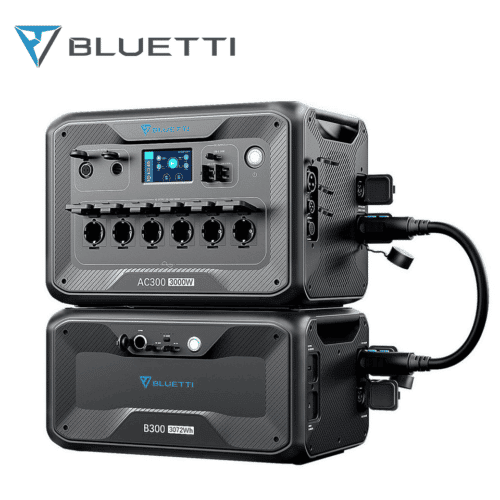
WINNER: BLUETTI AC300+2xB300
BEST POWER STATION FOR LARGE FIXED ELECTRICAL SYSTEMS (E.G., RVS)
BATTERY: 494Ah
INVERTER: 300Watt
DC: 50Amp
WEIGHT: 64Kg (!)
SOLAR: Max. 2400Watt
WHAT CAN YOU FEED US?
An entire camper with all its utilities on both 12V and 110-220V. Really everything.
7. Takeaways and Conclusion
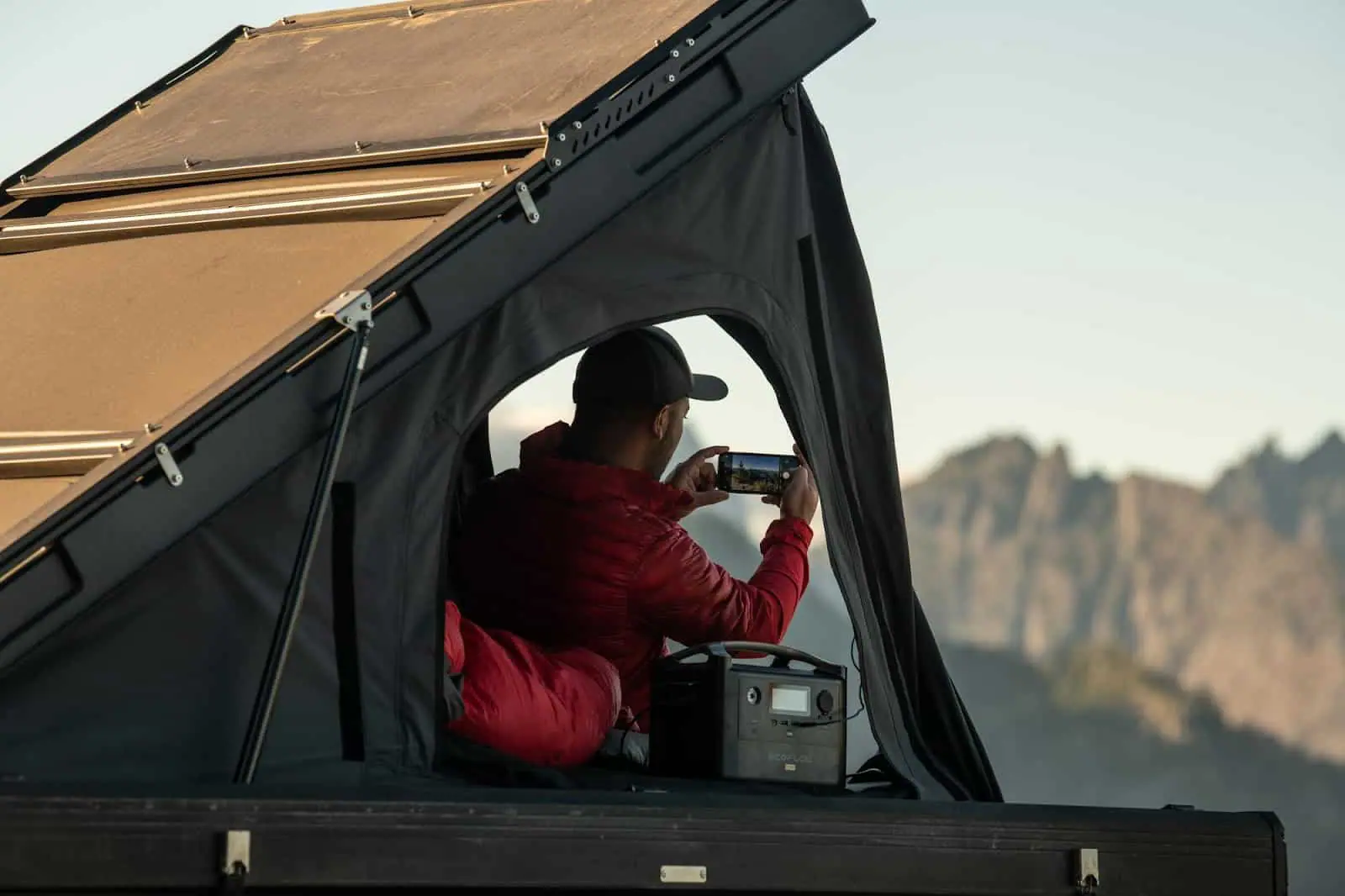
TAKEAWAYS: THINGS TO KNOW ABOUT POWER STATIONS FOR RV
Below you will find the main Takeaways from our market research:
- Bluetti and Ecoflow at the moment are still the market leaders and dominate the other alternatives
- The strong support from social and influencers for Bluetti is well-founded, in fact its products have won in 3 out of 4 categories.
- Bluetti is the only portable power station manufacturer to consider if you are serious about powering a 12V system in an RV.
- Still speaking of RVs, portable Power Stations are a great product to use as a back-up, extend your energy range, and to better enjoy outdoor life
- In contrast, for the same power, a Power Station can cost more than twice as much as a fixed RV electrical system
THE BEST PORTABLE POWER STATIONS FOR CAMPERS – SUMMARY
The Best Portable Power Station for charging cell phones, PCs and powering small appliances up to 600W is theBluetti EB3A.
The Best Portable Power Station for barbecues, outdoor parties, charging cell phones, PCs, and powering home appliances up to 1400W is the Ecoflow Delta Mini.
The Best Power Station to keep in your RV as an energy back-up or to increase the range of your existing system is theBluetti A200 Max.
The most powerful expandable power station that could be used to power an entire RV with both AC and DC consumers is the Bluetti AC300+2xB300 (Power Station + two batteries).
Note: depending on the period, you may find offers/prices that make other options more attractive. Personally, I recommend that you always refer to the manufacturers’ sites for optimal evaluation:Bluetti e Ecoflow.
CONCLUSION

A power station, although unlikely to compete with an RV’s electrical system, both in terms of power and price, is a really interesting accessory for supplementing and expanding one’s electrical system.
The most logical reasons for having one in an RV are as a back-up solution, to increase one’s energy range, and of course to enjoy outdoor camping without giving up any comforts.
How about you, what do you think? Was the article helpful to you? Have you already had experience with any Portable Power Station? Or do you simply have some observations to make?
If you’d like, please write to me in the comments below: it’s always nice to chat and of course leaving your experience for those who read after us is a selfless and always welcome gesture 🙂
If you are converting a van DIY and you are only now approaching the electrical system for the first time, I also leave you with this article that might help you get started: Complete Guide with Electrical System Diagram..
As always, I thank you for reading,
and see you in the next in-depth! 🙂
BEFORE YOU GO, CAN I ASK YOU FOR SOME FEEDBACK?
Writing detailed articles like this takes a lot of time and effort..
If you liked it, can I ask you to leave me a feedback message in the comments at the bottom of the page?
For a content-creator, knowing that you are being read and that your efforts are useful to someone is the best motivation to keep writing and doing better 🙂
Let me know what you liked or what you think could be added.
If you’d like, you can also share the article to help other people find it!
Thanks for the help 🙂

Read the Van Conversion Guides
How to Calculate the Right Section of 12V Cables | EASY GUIDE
An undersized cable does not carry enough current. A cable that is too undersized can lead to a fire. An oversized cable, on the other hand, simply costs more and is a waste of money. Are you wondering what is the logicfor choosing one section of cable over...
Van Conversion DIY: How Much Does It Costs? | My Experience
How much does it cost an entirely DIY van to campervan conversion? The queen of all questions... In this article, I want to show you all the costs of my conversion from start to finish, so that you too can get an idea of what it might cost! ...
Van Electrical Diagrams for your DIY Project – Ready to Install
The Electrical System is often one of the most complicated steps in a DIY van conversion. How much energy is needed? What apparatus/devices to purchase? How to connect them? How much would it cost? These are all doubts and questions that normally everyone finds...
Van Interior Conversion: Best DIY Ideas for your Project!
The Interior Outfitting of a DIY converted van is both an aesthetic and structural choice. In this article, you will find useful information and inspiration ideas for customizing the Walls, the Ceiling, and the Floor of your Van! DIY CAMPERVAN SET-UP:...
Kitchen for Camper | Best DIY Ideas for your Van Conversion
Cooking in Camper is one of those things, that makes you feel at home wherever you are! Gas, Diesel or Electric Stove? What equipment and accessories you need on the Road? How much space do you need? How to assemble the kitchen in your Camper? In this article you will...
The Best Fridge for Your Campervan – Which One to Choose?
Buying a trivalent or compressor RV refrigerator? Horizontal or vertical? 12V or 110/220V? In this article you will find all the information you need to choose the best fridge for Your Van, tailored to your Needs! 🙂 THE REFRIGERATOR IN THE VAN:...
Van Conversion: How to Build a DIY Bed for your Camper Van
A Camper is not a Camper if it does not have a bed. Where to Sleep and... Dream! In this Guide you can find the inspiration you need for creating a DIY Bed in Your Campervan, And I'll show you step by step how I built a Complete Bed/Dinette on my VW Crafter....
DIY Camper Bathroom: How to Self-Build a Toilet
If you are Campering a Van you surely must have wondered: How does the Bathroom in a Motorhome work? In this Guide I show you the various types of Bathrooms on the market, I explain how they work, and I show you how you can Build yourself an entirely...
Best 12V Fan for RV | DIY Installation Guide | Van Conversion
A Roof Fan helps keep your Vehicle's humidity under control and change stale air. In this guide you will find everything you need to know about mounting a Maxxfan Deluxe fan on the roof of YOUR van. ROOF FAN: WHAT IS IT FOR? Keeping an RV's...
How to Build a Shower in a Do-It-Yourself Camper
A Shower in the RV for some people is not necessary, for others it is a real necessity to be totally independent! In this guide I'll tell you how I built the shower of my converted van entirely Do-It-Yourself! INSTALLING A SHOWER IN A...
Complete Guide and Electrical Scheme for your D-I-Y Van Conversion
You dream of transforming your Campervan DIY and have never touched an electrical cable before? Or do you want to implement some changes to your Factory RV? In this guide you will find EVERYTHING (absolutely EVERYTHING!) you need to know to create the perfect DIY...
Converting a Van: How to Connect Electric Cables Without Mistaking
Want to know how to "connect" the electric cables in practice in a converted van? Stripping, Crimping, Wire Leads, Clamps, Tubing, Cable Ties and much more... You've come to the right place to learn All That! How to wire your van's electrical...

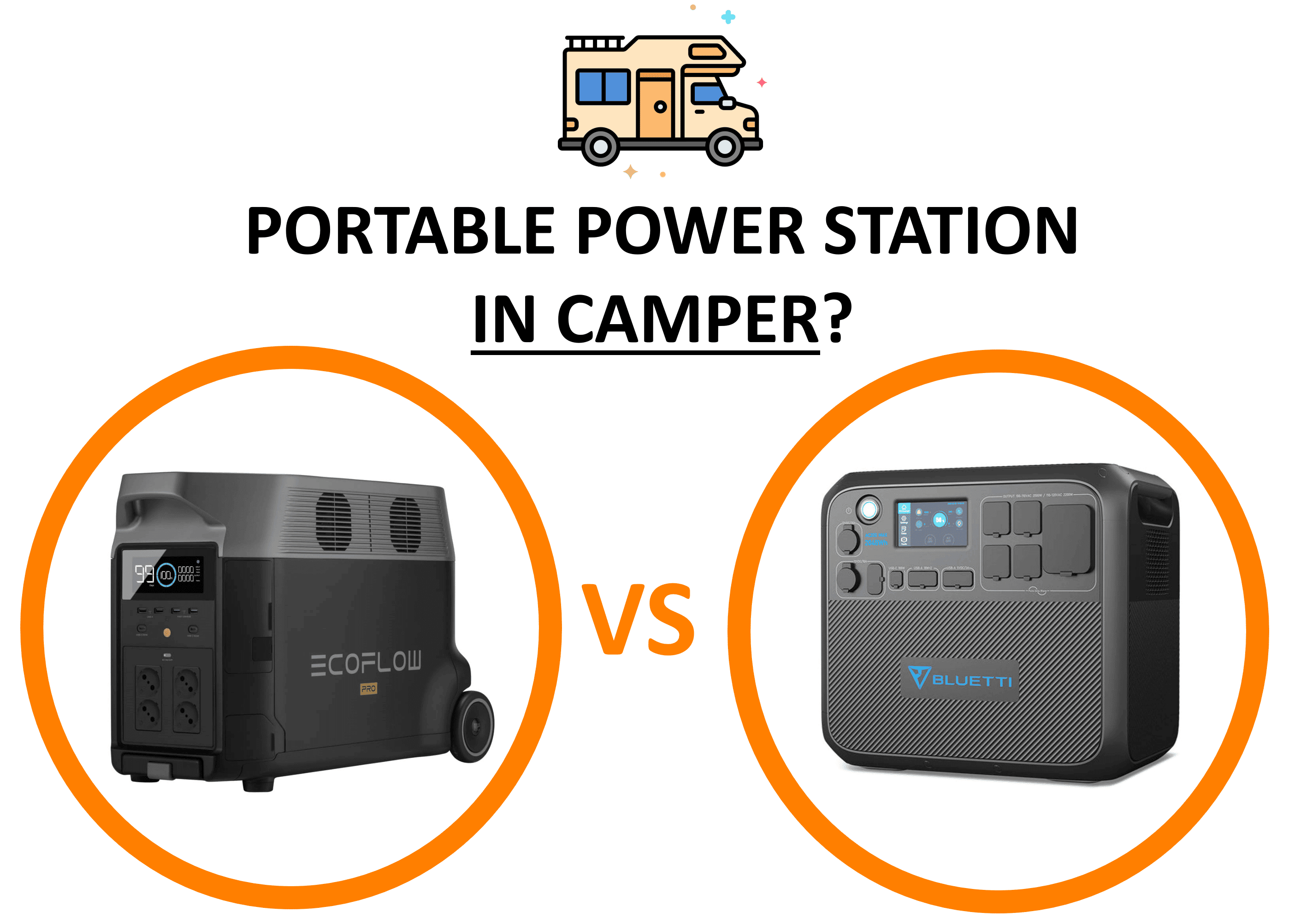
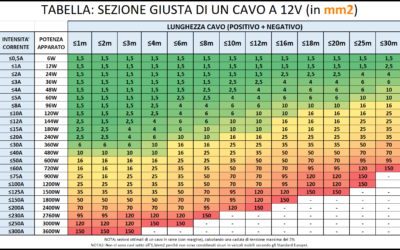

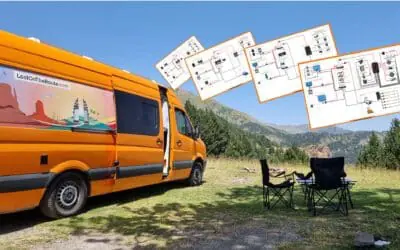



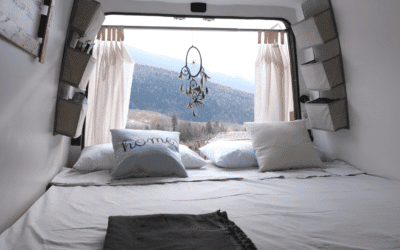
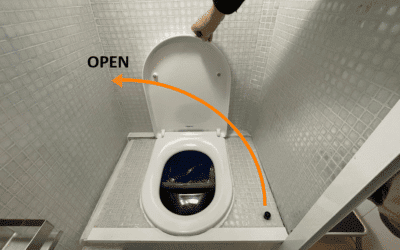

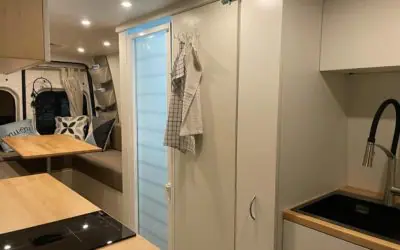
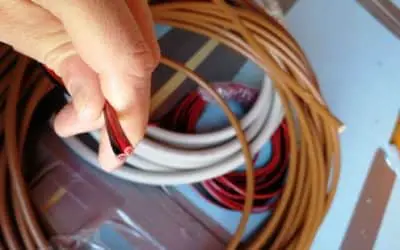
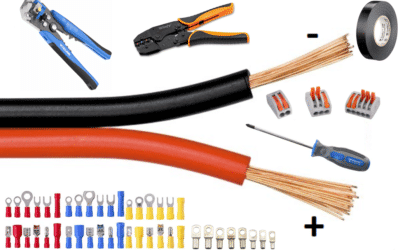



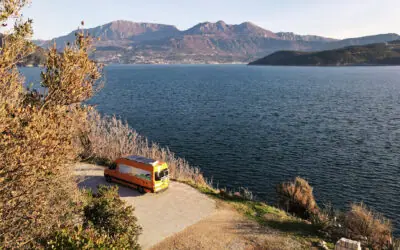
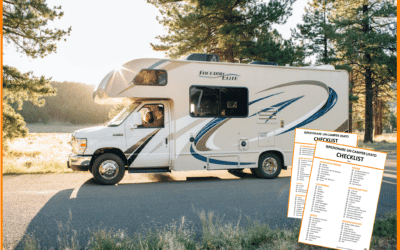



0 Comments